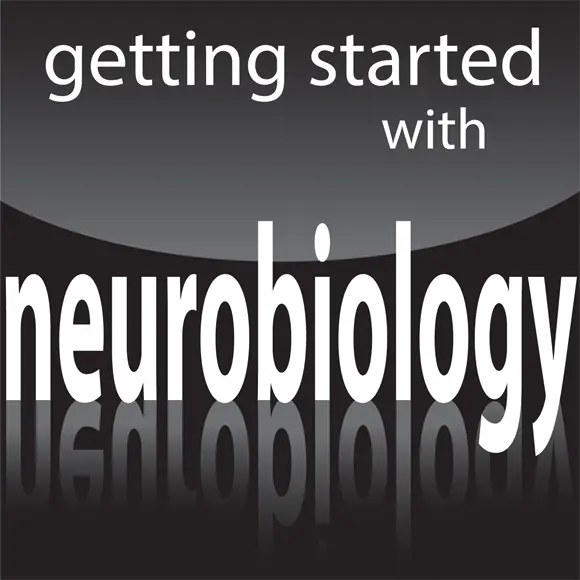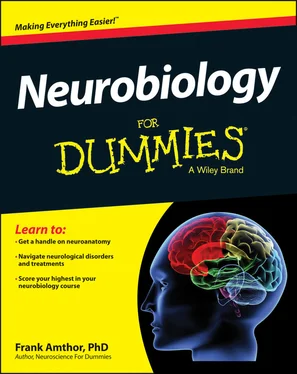 The Technical Stuff icon is about a recent or surprising finding that is not necessarily crucial to understand the chapter but is interesting or counterintuitive in its own right. You can skip these paragraphs and get by just fine, but you may miss some of the more interesting products of research.
The Technical Stuff icon is about a recent or surprising finding that is not necessarily crucial to understand the chapter but is interesting or counterintuitive in its own right. You can skip these paragraphs and get by just fine, but you may miss some of the more interesting products of research.
In addition to the material in the print or e-book you’re reading right now, this product also comes with some access-anywhere goodies on the web. Check out the free Cheat Sheet at www.dummies.com/cheatsheet/neurobiology for interesting information on whether paralysis can be cured, whether the mind can be downloaded, whether cyborgs are possible, and more.
Also, check out www.dummies.com/extras/neurobiology for articles on everything from where consciousness exists in the brain to how vision can be restored to the blind.
You can start reading this book anywhere — you don’t have to read it in order from beginning to end. Still, Chapter 1is a great place to start if you’re looking for an introduction to neurobiology. For more on common diseases and disorders, turn to Part IV. And if you’re short on time, Chapters 19and 20pack a powerful punch in not many pages.
I’m always interested in hearing from readers, so whether you find an error or you’d like to make any other comments about this book, feel free to contact me at amthorfr@gmail.com .
Part I
Getting Started with Neurobiology

 For Dummies can help you get started with lots of subjects. Visit
For Dummies can help you get started with lots of subjects. Visit www.dummies.com to learn more and do more with For Dummies.
In this part …
Find out what makes neurons different from other cells in the body.
Discover the genetics common to all cells and what happens when neurons have genetic mutations.
See what neurons need in order to be able to detect and respond to other neurons, substances in the environment, and energy.
Look at how neurons communicate with each other using electrical current flowing through ion channels.
Chapter 1
Welcome to the World of Neurobiology
In This Chapter
 Getting to know the neuron
Getting to know the neuron
 Finding out how the nervous system is organized
Finding out how the nervous system is organized
 Feeling cerebral with thoughts, learning, and memory
Feeling cerebral with thoughts, learning, and memory
 Seeing the effects of mental illness and developmental problems
Seeing the effects of mental illness and developmental problems
What makes you you? Your brain, most people would answer. Then what is it about your brain that makes you you? The brain is made of neurons. Worms have brains with neurons. So do dogs and monkeys. What about the brain distinguishes these animals from each other, and for that matter, one human from another? Is it more neurons, different neurons, special neural circuits?
Neurobiologists would like to answer all these questions, but they can’t yet. Thousands of them at universities all over the world are working on these problems. They have many hypotheses and data sets. This book, in a way, is a progress report on their efforts.
Virtually all neurobiologists believe that intelligence comes from nervous systems that are broadly programmed by genes and fine-tuned by experience. Generally, the human genetic program creates a brain with more neurons than any other animal, allowing for richer experience to produce a unique kind of intelligence.
This chapter gives an overview of the brain, its functions, and its parts. It also looks at why humans are like many other animals, such as primates, because of similarities in our brains, and what differences in the human brain may distinguish us from other species, and from each other.
Neurobiology is the study of neurons and nervous systems, such as brains. Neurons are cells. Like other cells, neurons interact with the external world and other cells through specialized receptors in their membranes and through biochemical processes inside their cytoplasm and nucleus.
Neural capabilities evolved from those of single-celled organisms, like bacteria and paramecia, which use membrane sensors to detect food and toxins, and cilia to move toward food and away from toxins. Single-cell organisms may also change their internal metabolism upon ingesting particular substances from the environment.
 Multicellular organisms consist of different types of cells that are specialized to do things like secrete hormones or digestive enzymes. They depend on other cells for nutrients, waste removal, and the maintenance of a supportive environment. Neurons are specialized cells in multicellular organisms that, among other things, enable rapid communication across the large distances from one end of an animal to another. This allows the animals to perform coordinated movements and to act upon sensing the surrounding environment.
Multicellular organisms consist of different types of cells that are specialized to do things like secrete hormones or digestive enzymes. They depend on other cells for nutrients, waste removal, and the maintenance of a supportive environment. Neurons are specialized cells in multicellular organisms that, among other things, enable rapid communication across the large distances from one end of an animal to another. This allows the animals to perform coordinated movements and to act upon sensing the surrounding environment.
Evolving cells on early earth
According to astronomers and astrophysicists, the universe as we know it came into existence about 14 billion years ago. After several cycles of star formation, our solar system, including the earth, formed about 4.5 billion years ago. The earth was too hot for life for about a billion years, as it continued to be bombarded by the solar system debris from which it was formed.
Eventually most of the solar system debris stuck to one or another planet, or stabilized in relevantly permanent orbits such as the asteroid belt between Mars and Jupiter. Earth cooled for about 1 billion years, and life arose. No one knows how. Some scientists are suspicious that life arose almost as soon as the earth was cool enough, suggesting either that it must occur almost automatically given the right conditions, or it came from elsewhere and established a foothold as soon as it was possible.
Looking at the origin of single cells
The living things that arose at the 1-billion-year mark were single-celled prokaryote cells that lack a nucleus, such as bacteria we have today. Life stayed unicellular for a long time after that. This doesn’t mean that no progress was made, though. Undoubtedly the single cells that existed at the time of evolution to multicellularity were more sophisticated and diverse than those that could be found when life originated.
Catalyzing reactions in the primordial soup
All life forms carry out metabolism, using energy to build proteins and other cell constituents. The proteins in all cells are coded for by the same DNA coding scheme (see Chapter 2), one piece of evidence that argues for a common origin of all life. A particularly important type of protein that all cells make is an enzyme. Enzymes cause specific reactions such as cleaving proteins at a particular place or joining proteins to other molecules.
Читать дальше

 The Technical Stuff icon is about a recent or surprising finding that is not necessarily crucial to understand the chapter but is interesting or counterintuitive in its own right. You can skip these paragraphs and get by just fine, but you may miss some of the more interesting products of research.
The Technical Stuff icon is about a recent or surprising finding that is not necessarily crucial to understand the chapter but is interesting or counterintuitive in its own right. You can skip these paragraphs and get by just fine, but you may miss some of the more interesting products of research.
 For Dummies can help you get started with lots of subjects. Visit
For Dummies can help you get started with lots of subjects. Visit  Getting to know the neuron
Getting to know the neuron Multicellular organisms consist of different types of cells that are specialized to do things like secrete hormones or digestive enzymes. They depend on other cells for nutrients, waste removal, and the maintenance of a supportive environment. Neurons are specialized cells in multicellular organisms that, among other things, enable rapid communication across the large distances from one end of an animal to another. This allows the animals to perform coordinated movements and to act upon sensing the surrounding environment.
Multicellular organisms consist of different types of cells that are specialized to do things like secrete hormones or digestive enzymes. They depend on other cells for nutrients, waste removal, and the maintenance of a supportive environment. Neurons are specialized cells in multicellular organisms that, among other things, enable rapid communication across the large distances from one end of an animal to another. This allows the animals to perform coordinated movements and to act upon sensing the surrounding environment.










